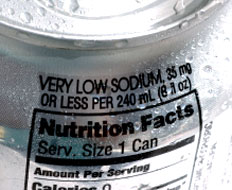In recent weeks, I’ve had the opportunity to speak with a number of food-industry leaders about technology and choice in our food supply. These discussions have centered on what consumers want. There appears to be a growing list of examples where consumer choice was compromised when companies made product changes or rejected technologies based on the vocal voice of the “fringe” and not the desires of most consumers. Irradiation, Golden Rice, salt, and high fructose corn syrup (HFCS) are several of the examples.
Let’s take a look at high fructose corn syrup. In an effort to please customers, a number of companies have made label and ingredient changes to everything from ketchup and crackers to bread and beverages to limit high fructose corn syrup, often at added cost and with no scientific basis for the change.
But a recent QSR article titled “Consumers Don’t Mind Feeding Sweet Tooth with HFCS” highlighted a Mintel study that showed just 4 percent of consumers say they are actively limiting or avoiding high fructose corn syrup, compared with 37 percent who are limiting calories and 20 percent who are limiting fats. Once again, the efforts of fringe groups seeking to ban HFCS are creating “noise” about an issue that is not top of mind for most consumers. Why not let consumers decide whether they want to purchase foods containing HFCS?
Sodium is another ingredient that’s come under fire by the vocal fringe groups. We’ve seen major brands make significant sodium reductions in response, only to see sales decline as taste was compromised.
An iconic soup brand responded to the vocal minority's campaign for lower-sodium foods by dropping sodium content in many of its soups in early 2010 in what it thought was an effort to please customers. Yet soon after the change, the brand’s sales started to decline. Many customers were left wondering what happened to the great taste of their favorite soups. The company recently announced that it is returning to the recipes that made its soups pantry staples for generations. Its efforts include planning taste improvements to 46 existing soups, introducing new products, and offering its customers the choice of reduced-sodium or traditional recipe soups.
In both of these instances, we believe it’s appropriate to add product SKUs or choices to meet the needs of the vocal fringe, but not making changes at the expense of the majority, particularly if it means adding cost to the supply chain.
The company’s move to bring back taste reflects the findings of recent consumer research Elanco conducted. An evaluation of 28 studies representing nearly 100,000 consumers in 26 countries found 95 percent of consumers want taste, cost, and nutrition when making food purchase decisions. Another 4 percent of consumers are looking for lifestyle choices, like gourmet, organic, or locally grown. For this segment, money isn’t a concern. This type of choice is a privilege and a higher margin opportunity for suppliers, but those production practices won’t allow us to meet global food supply needs.
Beyond economic implications, taking away choice poses food safety and health considerations. Irradiation and Golden Rice are two examples that come to mind. In the case of irradiation, consumer perception prevents the widespread use of a long-approved technology to help prevent food-borne illness. Golden Rice, a modified strain of rice that contains beta-carotene and could help prevent blindness and death from Vitamin A deficiency, has been on hold for most of a decade due to concern generated by the fringe.
So what does the consumer really want? Ultimately, it’s safe, affordable, trustworthy food. To deliver that, there are three things that must happen.
Consumer choice must reign. We can add SKUs to meet the niche needs of those fringe consumers, but we can’t continue to make changes based on noise from fringe groups that jeopardize cost of production, limit choices, and don’t account for the desires of most consumers.
We can’t compromise our ability to provide the safest, most affordable food supply in the world. Certainly, hunger is a substantial problem in the developing world. But it’s also a real and growing problem right here at home. We don’t have the luxury of adding cost to our supply chain. Taking away affordable, safe ingredients or proven technologies is not an option.
We must build consumer trust. Conflicting and confusing messages on food labels don’t differentiate products or brands, they decrease consumer trust in our food supply. As a food chain we have to collaborate, providing consumers with positive and transparent information that maintains category confidence and growth, to continue building trust with consumers
What menu decisions are you considering that could be based on the fringe and not the majority of consumers? How is your restaurant responding to consumers’ appetite for choice?













